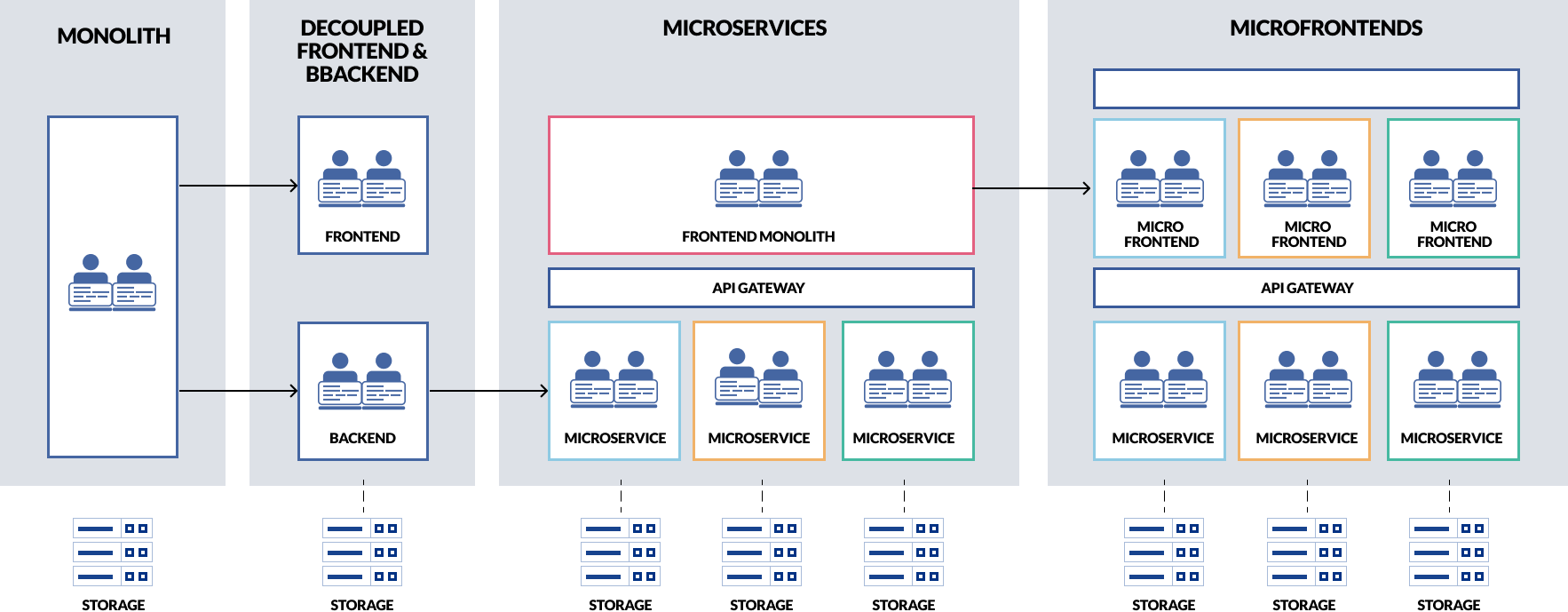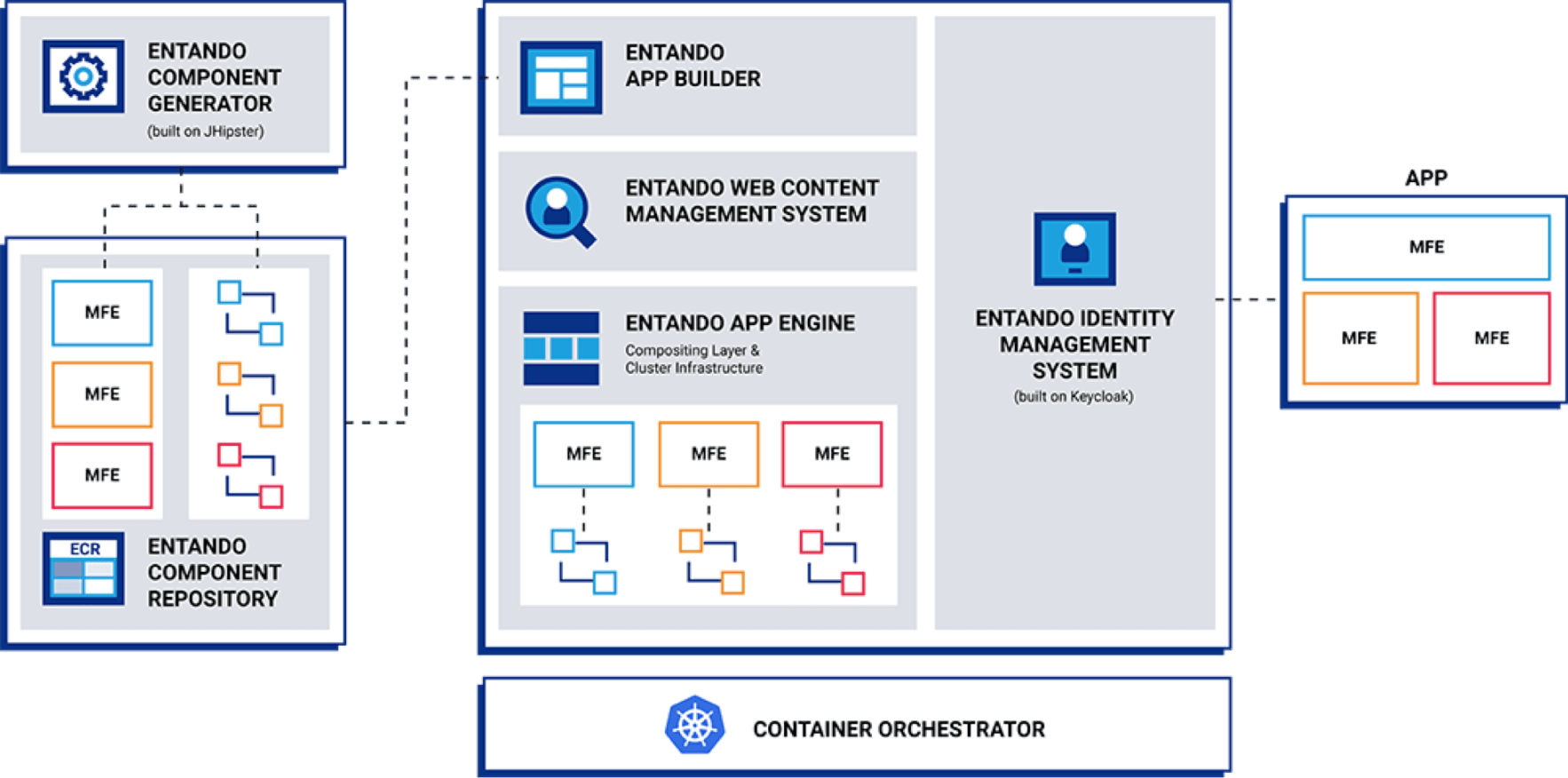
This article was contributed by guest author Dale Chamberlain, Marketing Manager of Entando. Click to read more from Dale or to learn more about Entando.
In order to win and retain customers online, your brand needs to provide user experiences that are fast and intuitive. They need to load quickly and consistently, and they need to be easy to navigate. And in order to provide modern UX, you need to be utilizing leading edge tools, technologies, and methodologies to get your ideas to market quickly and effectively.
One development trend that is helping large organizations to remain agile and deliver better UX faster is micro frontends. More than simply a new technology choice for the frontend developers, micro frontends allows an entire enterprise to change the way its teams function, extending DevOps processes to the frontend.
Here’s a closer look at how micro frontends came to be an increasingly popular development methodology, the benefits of developing with micro frontends, as well as how a micro frontend platform can help.
The Evolution of Frontend Development
Before the advent of microservices, application architectures were often organized in a monolithic structure–whether as a single monolith or as decoupled backend and frontend monoliths.
This works incredibly well for simpler applications, but as the size of codebases and the demand for more complex functionality increases, the backend monolith becomes too cumbersome for development teams to manage in an efficient way. This is the problem that microservices were introduced to solve.
With microservices, independent teams are able to work on backend functionality in isolation from different parts of the site. This streamlines the development process and accelerates the timetable for any one update to be deployed. However, in many organizations, the frontend monolith remains. So micro frontends serve as yet another natural progression toward decoupling functionality to improve team agility.
By extending this decoupling from the backend all the way up to the frontend, enterprises can structure teams vertically around a specific business goal or outcome, rather than horizontally around a particular technical skill set. This allows a team to focus not only on achieving a technical objective, but working holistically toward the business function.
Some Goals Micro Frontends Help You Achieve
Micro frontends are most beneficial to large organizations with complex business needs that need to be supported by an equally complex network of app features. They are particularly beneficial to the enterprise trying to achieve the following goals.
Deliver on the business goals of many different stakeholders
As your business scales, you may find that you’re attempting to deliver on the business goals of any number of stakeholders, both internally and externally. Managing all of these important goals and needs can become unwieldy when you’re developing frontend applications with a monolithic architecture.
Micro frontends enable you to decouple functionality and reorganize yourself around your various business functions and goals. This enables your teams to give focused attention to each stakeholder’s needs, both within your organization and outside it.
Give your teams greater independence
With micro frontends, you have the ability to spin up a new team to build and deploy a new feature or functionality without negatively affecting other parts of your site or business. This gives each team important decision making power, also eliminating the need to coordinate across teams to implement.
Migrating to more modern architectures and tools
It may be good to consider transitioning to a micro frontend architecture when you’re already modernizing other aspects of your development processes, such as moving to Kubernetes. When you change that infrastructure, that’s an opportunity to reorganize your business around something like micro frontends.
Improve resiliency
As you seek to move toward a more automated deployment architecture, micro frontends help you to isolate failures by moving you toward a more modular architecture, which improves resiliency.
What Is A Micro Frontend Platform?
While making the decision to develop in micro frontends will bring many benefits, it will also introduce a new level of complexity to your development process, particularly if you are leveraging containerized deployments on Kubernetes. A micro frontend platform can help you manage this complexity while maintaining speed of innovation.
A micro frontend platform provides developers with tools to rapidly build, design, and assemble applications from micro frontends, microservices, and web content.
One of the tools a micro frontend platform provides is a component generator, which enables you to rapidly generate customized micro frontends and microservices to be used for your application. You can also do this via the command line.
These components are then made available to be installed in your application in a shared component repository. This enables you to reuse micro frontends across multiple projects, which will allow you to increase the rate of development in successive projects, as well as more easily build standardization into your development process.
A micro frontend platform also provides a UI interface to lay out and assemble your micro frontends into an application, portal, or website. You can pull micro frontends and microservices from the component repository, deploy them to your server cluster, and then have them wired together by the cluster infrastructure.
The ability to wire micro frontends and microservices deployed in containers together is one of the key elements that a micro frontend platform provides, the main benefit being that it simplifies the life of the enterprise on Kubernetes. The next step before the application is displayed to the end user is the compositing layer, where micro frontends are dynamically assembled together.
A micro frontend platform also comes with a web content management system so you can create web content in your application along with your micro frontends. Having a WCMS enables the non-technical members of your organization to have control over the content for your site, app, or portal without needing help from your developers.
How Entando and Veriday Can Help
When release cycles take months instead of weeks, your business is left unable to deliver modern online experiences. Development bottlenecks slow your ability to make application updates, keeping you from iterating and innovating. And outdated or clunky UX keeps you from winning customers over and retaining them.
Veriday’s experts will help you implement an end-to-end vision by creating a modern development stack for building enterprise applications using Kubernetes. Veriday is a certified partner of leading micro frontend platform, Entando. We will empower your team to rapidly build, design, and assemble applications from micro frontends, microservices, and web content.
Entando is the leading micro frontend platform for building enterprise web apps on Kubernetes.
With Entando, you can leverage the Component Generator built on JHipster to create micro frontends and assemble them onto a single page. Then reuse UI/UX components across multiple projects via the Component Repository, saving money and increasing development speed.
Begin developing on Entando today, to learn about Veriday’s suite of Micro Services and DevOps capabilities to help your enterprise build better apps, sites, and portals–faster.
Talk with the experts
Sam Hyland
VP, Professional Services
Sudipto Ghosh
Sr. Director – Innovation in PS













